Washington Irving
- 格式:ppt
- 大小:3.22 MB
- 文档页数:36





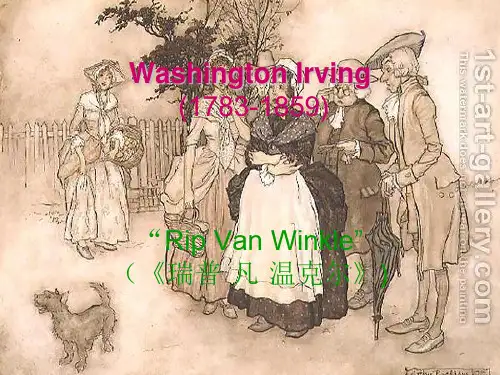
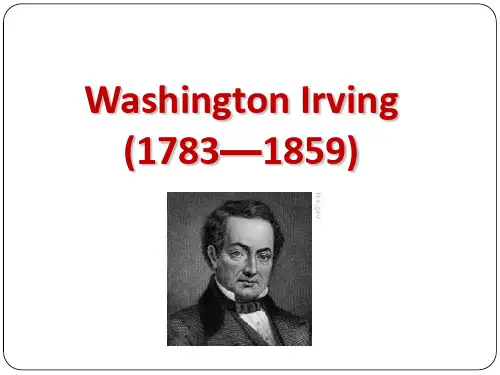
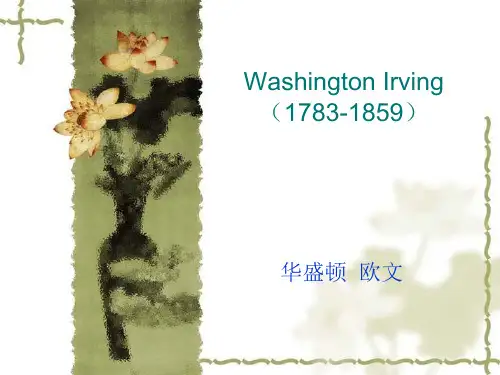
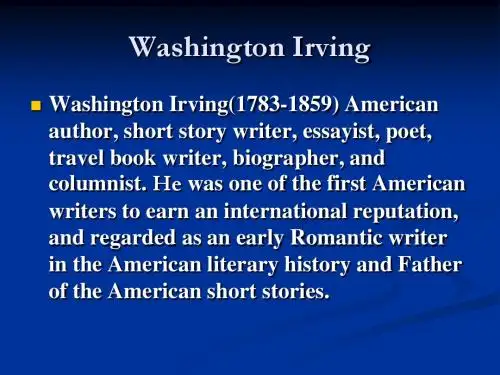
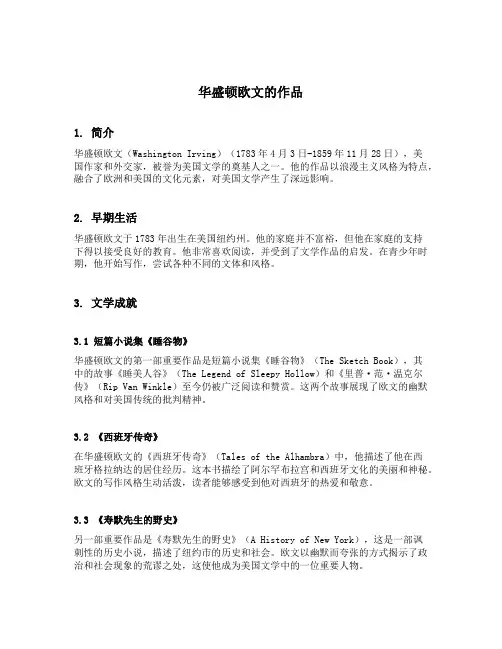
华盛顿欧文的作品1. 简介华盛顿欧文(Washington Irving)(1783年4月3日-1859年11月28日),美国作家和外交家,被誉为美国文学的奠基人之一。
他的作品以浪漫主义风格为特点,融合了欧洲和美国的文化元素,对美国文学产生了深远影响。
2. 早期生活华盛顿欧文于1783年出生在美国纽约州。
他的家庭并不富裕,但他在家庭的支持下得以接受良好的教育。
他非常喜欢阅读,并受到了文学作品的启发。
在青少年时期,他开始写作,尝试各种不同的文体和风格。
3. 文学成就3.1 短篇小说集《睡谷物》华盛顿欧文的第一部重要作品是短篇小说集《睡谷物》(The Sketch Book),其中的故事《睡美人谷》(The Legend of Sleepy Hollow)和《里普·范·温克尔传》(Rip Van Winkle)至今仍被广泛阅读和赞赏。
这两个故事展现了欧文的幽默风格和对美国传统的批判精神。
3.2 《西班牙传奇》在华盛顿欧文的《西班牙传奇》(Tales of the Alhambra)中,他描述了他在西班牙格拉纳达的居住经历。
这本书描绘了阿尔罕布拉宫和西班牙文化的美丽和神秘。
欧文的写作风格生动活泼,读者能够感受到他对西班牙的热爱和敬意。
3.3 《寿默先生的野史》另一部重要作品是《寿默先生的野史》(A History of New York),这是一部讽刺性的历史小说,描述了纽约市的历史和社会。
欧文以幽默而夸张的方式揭示了政治和社会现象的荒谬之处,这使他成为美国文学中的一位重要人物。
4. 文化影响华盛顿欧文通过他的作品对美国文学产生了深远影响。
他的风格和主题在后来的作家中得到了广泛的传承和发展。
他的作品对美国的文化认同和国家形象的塑造有着重要意义。
5. 总结华盛顿欧文是美国文学的先驱和奠基人之一,他的作品以浪漫主义风格和幽默风格为特色。
他通过讽刺和揭示人类社会的荒谬性,展示了对美国文化和传统的深入理解。
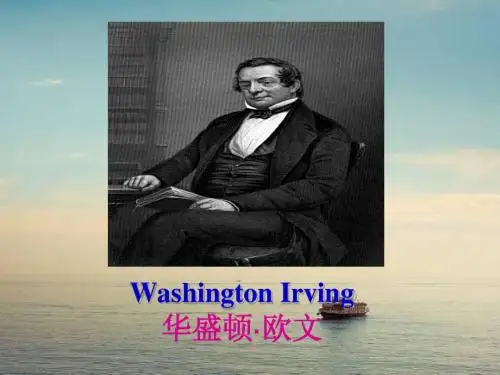
Washington Irving:Founder of American Literature美国文学之父——华盛顿·欧文Washington Irving (April 3, 1783 – November 28, 1859) is one of the earliest romantic writers in American known for his sketches, short stories and biographies, Irving is the first U.S. author to achieve international renown.华盛顿·欧文生于1783年4月3日,死于1859年11月28日,他是美国最早的浪漫主义作家之一,他以笔记、小说和传记而闻名,是第一位获得国际声誉的美国作家。
Absorbing the cream of European culture and literature, Irving created his unique style that is fresh, natural, humorous and musical. With his short stories and success in many other fields, Irving has made great contributions to the development of independent American literature. It is Irving who activated the potential of American literature and laid solid foundations for its future development. As a famed essayist, biographer, historian, writer and politician, Washington Irving is often considered as “The Father of American Literature”or “The Father of American Letters,” as well as one of the inventors of the modern short essay and fiction.欧文汲取欧洲文化和文学的精华,创造了自己独特的风格,其文笔清新、自然、诙谐、富于乐感。
Washington Irving (1783--1859)Washington Irving was an American author, essayist, biographer, historian, and diplomat of the early 19th century.Life●Irving was born in a wealthy New York merchant family.●He studied law but he loved writing more.●In mid 1815, Irving left for England to attempt to salvage the family tradingcompany. He remained in Europe for the next seventeen years.With no job prospects, he had to write to support himself.●In the summer of 1817, he visited Walter Scott and began a lifelong personal andprofessional friendship.●In 1819, Irving published a set of short prose pieces named The Sketch Bookwhich was later proved to be an enormous success.●The following two years after the publication of The Sketch Books, Irving stilllived in Paris and Britain, where he was often feted as an anomaly of literature, an upstart American who dared to write English well.●In 1826, as an American diplomatic attache, Irving was sent to Spain,➢where he gathered materials for his The History of the Life and Voyages of Christopher Columbus (in the form of romantic history)which was popular in the United States and in Europe. This book was published firstly with Irving’s own name instead of a pseudonym on the title page.➢He also received the unfettered access to a Duke’s library containing many medieval manuscripts. Chronicle of the Conquest of Granada was published a year later.●Before Irving could continue to gather more materials from Spain, in 1829, hewas notified of his appointment as Secretary to the American Legation inLondon. So, he left Spain for England. He kept this mission for three years. In 1832, he resigned his post to concentrate on writing, completing Tales of the Alhambra.●Washington Irving returned to America in 1832 after seventeen years abroad.Later, he purchased a neglected cottage in Tarrytown, New York and named it Sunnyside. (But this cottage needed constant repairing over the next twenty years which cost Irving a lot. With costs of Sunnyside increasing, Irving reluctantly agreed to become a regular contributor to The Knickerbocker magazine.)●Irving spent the rest of his life living in Sunnyside, except for a period of fouryears’ life in Spain as American minister. (1842-1846)●During his leisure and comfortable life at Sunnyside, Irving completed hisbiographical series, such as Life of Goldsmith and a five-volume Life of Washington. However, only after 8 months after his completing the final volume of his Washington biography, Washington Irving died of a heart attack. He was unmarried during his lifetime.Career●1809--1832 The first phase spans from his first book up to 1832 when hereturned home.➢The first period was predominantly “English”, in which he was greatly obsessed with the ruins and relics of Europe and writing about subjects either English or European.●The second phase stretches over the remaining years of his life. Back in America,Irving found a whole new spirit of nationalism in American feeling and art and letters. The country was eager for an indigenous culture and literature at that time.In the last years of his life, Irving wrote a few books about the American west to awoke to the fact that there was beauty in America, too. But these “American”books are of only secondary importance among his works.Works● A History of New York (his first success under the pseudonym of DiedrichKnickerbocker)➢The anecdotes of his cheating the readers about the crusty Dutch historian, Diedrich Knickerbocker, prior to his publication➢After the success of A History of New York, Irving searched for a job and eventually became an editor of a magazine.●The Sketch Books➢The Sketch Book is a collection of essays, sketches, and tales, of which the most famous and frequently anthologized are “Rip Van Winkle”and “The Legend of Sleepy Hollow”. The book touched the American imagination and foreshadowed the coming of Hawthorne, Melville, and Poe, in whose hands the short story attained a degree of perfection as a literary tradition.➢The Sketch Book also marked the beginning of American Romanticism.The Gothic, the supernatural, and the longing for the good old days which are exhibited in it are Romantic enough in subject.●The History of the Life and Voyages of Christopher Columbus●Chronicle of the Conquest of Granada●Tales of the Alhambra●Life of Goldsmith●Life of WashingtonContributionIrving’s contribution to American literature is unique in more ways than one.●Irving was the first American writer of imaginative literature to gain internationalfame.When he returned home in 1832, he was acclaimed as an American that European peopleknew about, and this was considered as a sign by Americans that American literature was emerging as an independent entity.●Irving was considered as father of American literature.The short story as a genre in American literature probably began with Irving’s The Sketch Book. a collection of essays, sketches, and tales, of which the most famous and frequently anthologized are “Rip Van Winkle” and “The Legend of Sleepy Hollow”.Writing Features●Irving’s style is beautiful, imitative and true. He never shocks the readers butseems a bit sentimental at times. His manner seems more important than his matter.●In his writings, Irving avoids moralizing but tends to amuse and entertain, whichis quite different from his Puritan forefathers.●Irving is good at enveloping his stories in an atmosphere. His characters are richand true so that they tend to linger in the mind of the reader. The tone is usually so humorous that it is difficult not to smile even chuckle for a reader.●Irving’s finished and musical language as well as his patent workmanship havebeen the focus of literary critics for a long time. He modeled himself on Goldsmith and was known as “the American Goldsmith” at that time.Rip Van Winkle“Rip Van Winkle” and “The Legend of Sleepy Hollow” are the most famous stories in The Sketch Book. They are so famous and enduring in the history of American literature that they have become part of the American cultural tradition.●Rip Van Winkle took suggestions from a German source. He changed the settingsand make it American.●The main plot➢The characters:Rip Van Winkle: He is a simple, good-natured, and hen-pecked man. He is very kindhearted and is always willing to help others except his wife and his own folks. He is welcome everywhere except at home. His would rather starve on a penny than work for a pound. Actually, his name has some connotative meaning. Rip may be the abbreviation for “Rest in Peace”.➢The shifting point:Couldn’t bearing his wife’s consistent dinning in his ears about his idleness, carelessness, he finds his refuge in the mountains with his gun and dog as his companions. One afternoon he stays out late near the top of a mountain where he meets a group of odd-looking people playing at nine-pins. Out of curiosity and thirsty, he take several sips of the wine and falls asleep. When he wakes up and returns to his village, he is shocked by the tremendous change in his village.➢The tremendous changes1)Old houses have vanished, and so have some of his old friends.2)The former little inn is replaced by a large “Union Hotel” with a flag of stars andstripes fluttering in front of it.3)The dispassionate idle talk about events and occurences were replaced by apassionate factional squabble.4)His wife died, he son has become a farm hand, and his daughter has become ahappy mother. He realized that what he thinks just one night actually is twenty years. He has slept for twenty years.➢The importance of nature1)Under Irving’s pen, nature has become the refuge to get far away from the worldcrowd.2)Nature has also become the reflection for the shifts and changes of life because ofits enduring characteristic. It also become the reflection for Rip to recognize himself. Some natural scenes in the story with the symbol of eternity are Castskill mountain region and Hudson river.●Theme➢ReclusionRip goes into the mountain to avoid his wife’s consistent blame. However, with coincidence, he also takes a refuge from the American Revolution which happens during his twenty years’ sleep. This reveals the conservative attitude of this author, Irving Washington.➢RevolutionRevolution is another theme in this story. However, Iring didn’t describe that revolution directly but focused more on the impacts that social revolution brought on people’s life and their reaction to this social change.The story might be taken as an illustration of Irving’s argument that change and revolution upset the natural order of things and of the fact that Irving never seemed to accept a modern democratic America.。